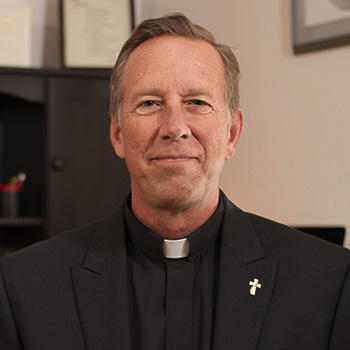
Although there are many remedies to the poisons of bad example, the saints stand as role-models of heroic sanctity, holiness, and fortitude. They are unique and unrepeatable persons of excellence for every age. St. Polycarp is one such person.
By Deacon Frederick Bartels
23 February 2019
One of the more difficult things to do as a Christian today is to actually live a Christian life. We’re surrounded by bad examples, so-called role models not of sanctify and love but of determined opposition to the will of God. We’re immersed in a culture of people who triumphantly place emotions on their personal throne in blatant contradiction to the throne of the Most High, people who deliberately ascribe to the culture of death that is at war with our loving Father in heaven who is the God of the living (Mk 12:27).
In such an atmosphere, there is no replacement for the example of the saints: men and women throughout the ages whose lives displayed heroic sanctity, holiness, love, and courage. The life and death of St. Polycarp provides us with just such examples. Polycarp truly imitated the self-sacrifice of Christ and took on his characteristics, remaining faithful to his principles all the way to the pyre. Polycarp’s life and especially his martyrdom stands as a testament of the way in which our lives can be transformed by Christ and become extraordinarily astounding, beautiful, and wondrous.
St. Polycarp was born in A.D. 69 or 70 and was a man well connected to the leaders of the early Church. He knew the apostle John who resided in Ephesus and was exiled to the Greek island of Patmos and perhaps lived into his 90s. Polycarp and some of his Christian followers met St. Ignatius of Antioch on his way to Rome to be fed to wild beasts in the amphitheater. During his journey to Rome, Ignatius wrote seven letters. All were addressed to churches save one that was addressed to Polycarp himself (1).
After a persecution in Smyrna broke out, Polycarp fled to the country and remained at a farmhouse in hiding. However, a Christian follower gave his whereabouts away under torture. Consequently, soldiers soon arrived to arrest him. This was no surprise to Polycarp, however, since prior to their arrival he had had a vision during a dream in which he saw his pillow catch fire. The account of his subsequent martyrdom was preserved by Pionus, who belonged to Polycarp’s flock (Ibid, 31).
The story of Polycarp’s capture and martyrdom is truly beautiful in its display of discipleship in conformity to Christ. In summarizing Pionus’s account, Dr. Marcellino D’Ambrosio writes:
Polycarp’s ordeal echoes the ordeal of his Lord Jesus Christ and is “a martyrdom conformable to the gospel.” Polycarp waited to be betrayed, just as the Lord did. He was captured on a Friday, the day Christ died. Like Jesus, he too prayed for his captors and his persecutors. In fact, when the authorities arrived at the farmhouse where he was staying, he got their permission to have an hour to pray before departing. While they waited for him to finish his prayer, Polycarp arranged for food and drink to be served to them.
D’Ambrosio, When The Church Was Young, 31.
When Polycarp arrived in the arena, he was interrogated by the proconsul in front of the crowd waiting there, composed of both Christians, who were called “atheists” for their refusal to worship pagan gods, and bloodthirsty pagan observers eager to see the Christian die.
The proconsul said, “Have respect for your age, Polycarp. Swear by the fortune of Caesar; change your mind; say, ‘Away with the Atheists!”
Infuriating the proconsul, Polycarp pointed at the pagans instead of the Christians and said, “Away with the Atheists!”
The proconsul responded, “Take the oath and I will release you. Curse Christ!”
Polycarp said, “Eighty-six years I have served him, and he never did me any wrong. How can I blaspheme my King who saved me? … If you vainly suppose that I shall swear by the fortune of Caesar, as you say, and pretend that you do not know who I am, listen plainly: I am a Christian. But if you desire to learn the teaching of Christianity, appoint a day and give me a hearing.”
The proconsul said dangerously, “I have wild beasts. I shall throw you to them, if you do not change your mind.”
Polycarp, filled with the zeal of the Spirit of Christ, replied, “Call them” (2).
However, the beasts would not be called. It had grown late and the animals were locked away in their cages. The pagan crowd took up the issue and suggested Polycarp be burned alive at the stake. It seemed to them a fitting and brutal end for the saint on that night. To carry out their plan, they set out to gather firewood for the pyre (3). Polycarp’s vision was soon to become a reality.
St. Polycarp, Bishop of Smyrna and a disciple of the apostles, suffered martyrdom in the amphitheater at Smyrna in about the year 155, by burning at the stake. Below is an account of his death from a letter on the martyrdom of Saint Polycarp by the Church of Smyrna.
When the pyre was ready, Polycarp took off all his clothes and loosened his under-garment. He made an effort also to remove his shoes, though he had been unaccustomed to this, for the faithful always vied with each other in their haste to touch his body. Even before his martyrdom he had received every mark of honor in tribute to his holiness of life.
There and then he was surrounded by the material for the pyre. When they tried to fasten him also with nails, he said: “Leave me as I am. The one who gives me strength to endure the fire will also give me strength to stay quite still on the pyre, even without the precaution of your nails.” So they did not fix him to the pyre with nails but only fastened him instead. Bound as he was, with hands behind his back, he stood like a mighty ram, chosen out for sacrifice from a great flock, a worthy victim made ready to be offered to God.
Looking up to heaven, he said: “Lord, almighty God, Father of your beloved and blessed Son Jesus Christ, through whom we have come to the knowledge of yourself, God of angels, of powers, of all creation, of all the race of saints who live in your sight, I bless you for judging me worthy of this day, this hour, so that in the company of the martyrs I may share the cup of Christ, your anointed one, and so rise again to eternal life in soul and body, immortal through the power of the Holy Spirit. May I be received among the martyrs in your presence today as a rich and pleasing sacrifice. God of truth, stranger to false hood, you have prepared this and revealed it to me and now you have fulfilled your promise.
“I praise you for all things, I bless you, I glorify you through the eternal priest of heaven, Jesus Christ, your beloved Son. Through him be glory to you, together with him and the Holy Spirit, now and for ever. Amen.”
When he had said “Amen” and finished the prayer, the officials at the pyre lit it. But, when a great flame burst out, those of us privileged to see it witnessed a strange and wonderful thing. Indeed, we have been spared in order to tell the story to others. Like a ship’s sail swelling in the wind, the flame became as it were a dome encircling the martyr’s body. Surrounded by the fire, his body was like bread that is baked, or gold and silver white-hot in a furnace, not like flesh that has been burnt. So sweet a fragrance came to us that it was like that of burning incense or some other costly and sweet-smelling gum.
Cap. 13, 2 – 15, 2: Funk 1, 297-299.
Photo Credit: See page for author [CC BY 4.0 (https://creativecommons.org/licenses/by/4.0)]
- Marcellino D’Ambrosio, When The Church Was Young: Voices Of The Early Fathers, 29.
- The Martyrdom of Polycarp 9-10.
- D’Ambrosio, When The Church Was Young, 32.

Deacon Frederick Bartels is a member of the Catholic clergy who serves the Church in the diocese of Pueblo. He holds an MA in Theology and Educational Ministry, and is a Catholic educator, public speaker, and evangelist who strives to infuse culture with the saving principles of the gospel. For more, visit YouTube, iTunes and Twitter.




Leave a Reply